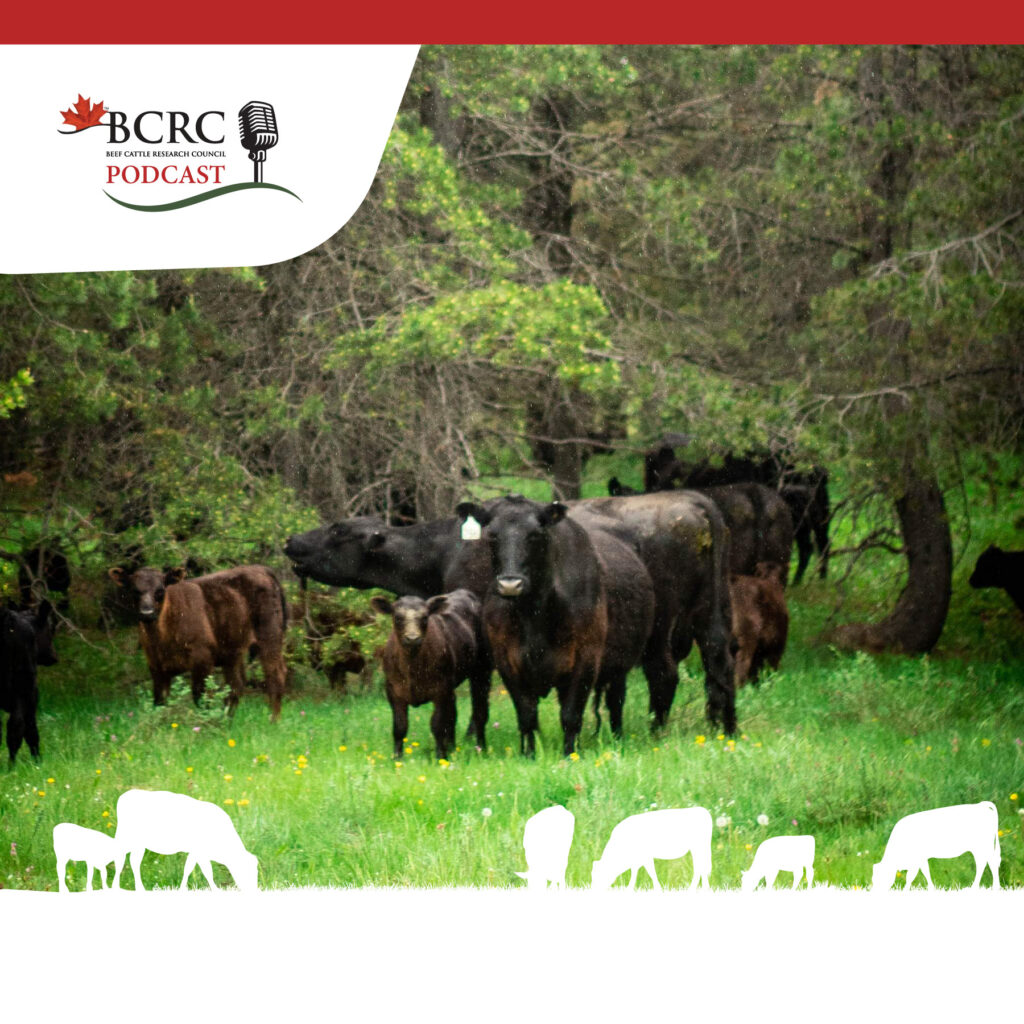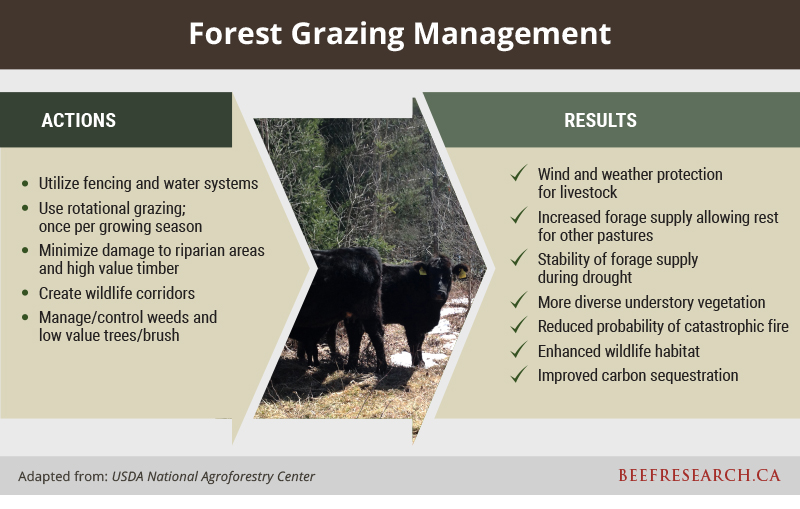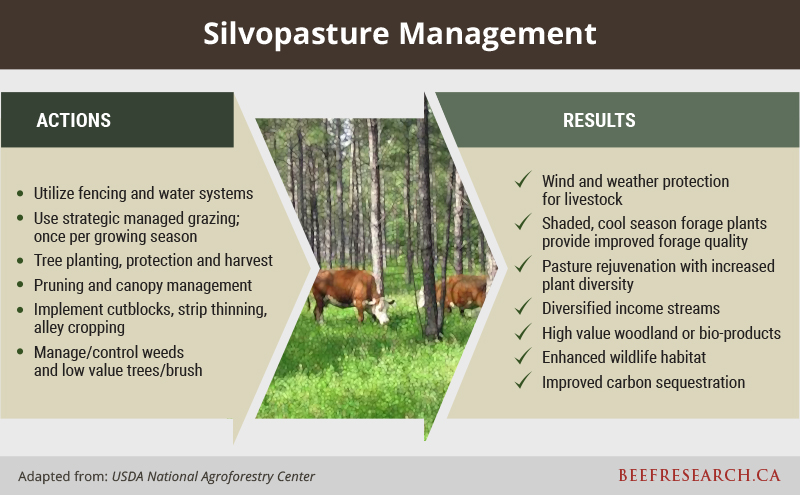Forested rangelands and partially or completely forested areas are widespread in many areas of Canada. Livestock producers use forest grazing to increase pasture acres, temporarily or permanently, while providing protection for livestock from the elements. Forest age, composition and management strategy will impact outcomes. Successful management of forested rangelands is achieved through sustainable stocking rates, livestock distribution, careful timing of grazing and rest periods after grazing. Forests function and respond to grazing differently than native grasslands or tame pastures and must be managed accordingly. Understanding the combination of forest and forage species for grazing, their growth habits, patterns and limitations provides tools to manage this resource.
| Key Points |
|---|
| Agroforestry is the practice of using trees, shrubs, plants and animals on the same land in an integrated system that benefits all, while potentially providing better economic returns than if the land was used for one purpose alone |
| Agroforestry can be implemented as simple methods that involve introducing animals into forested areas to access additional forage, to more complex systems that incorporate several compatible enterprises that can achieve efficiencies and economic resilience though income diversification |
| Provinces, territories and the federal government have developed laws and policies to enforce sustainable forest management |
| The primary use of the forested area is often determined by the main tree species |
| Forage value describes the palatability and nutritive value of plants to livestock |
| Forested rangelands are best grazed only once per season to maintain plant health and vigour and allow grazed plants to regrow and replenish energy reserves prior to winter |
| Grazing only 25% of the total forage production on forested rangeland is recommended |
| Timing of forest grazing is important. If plants are grazed too early, their energy reserves are reduced, negatively affecting their overall health and ability to produce new growth |
| The age of the forested area will influence the vegetation, wildlife and bird communities |
| Livestock behaviour and type of cattle must be considered when planning forest grazing |
Overview of Canadian Forests
Forests cover 367 million hectares of land in Canada and make up almost 35% of the total land area. The composition of Canadian forests is approximately 70% coniferous, 10% deciduous (broadleaf), and 16% mixed wood1. These areas generate many essential ecosystem goods that benefit society, including timber, mushrooms, berries and plants, and ecosystem services such as carbon sequestration, flood protection, clean air and water, recreation and other cultural services. Forested land also provides a diverse range of habitats supporting plant and wildlife biodiversity.
Forests within Canada and across the globe are very different. To allow for standard assessment of forests, a forest is defined as1:
- Having 10% or more of tree canopy cover
- Having frees over 5 metres
- Covers more than 1.2 acres (0.5 hectares)
- Not predominately under agricultural or urban land use
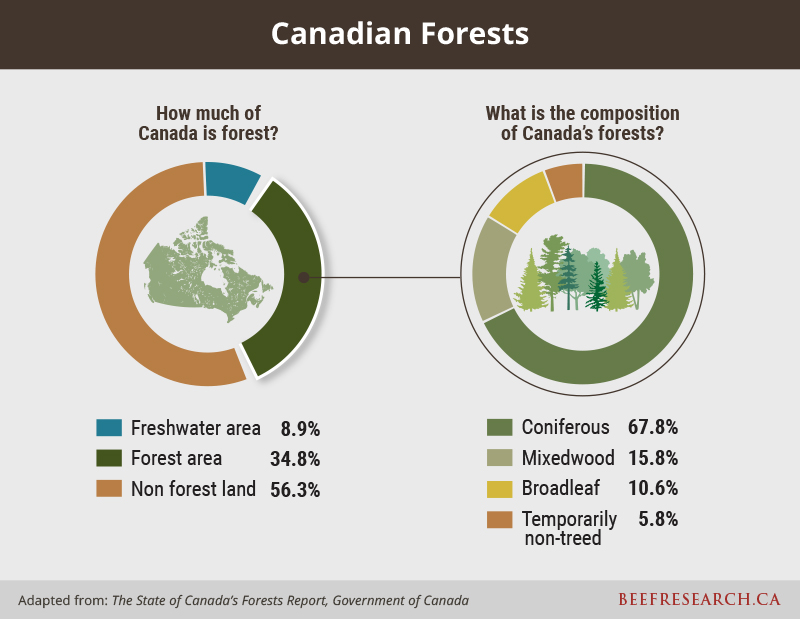
Trees in Canada are described as being either coniferous or deciduous. Conifers are often called softwoods or evergreens and are needle-leaved trees which generally do not lose their needles. Pine, fir and cedar are examples of conifers. There are some conifers, such as larch and bald-cypress, which are an exception and do lose their needles at the end of the growing season. Deciduous trees are often called hardwoods or broadleaf trees and they shed their leaves in the autumn. Maple, oak and birch are common deciduous trees.
Agroforestry is the practice of using trees, shrubs, plants and animals on the same land in an integrated system that benefits all, while potentially providing better economic returns than if the land was used for one purpose alone. In Canada, agroforestry primarily focuses on timber, livestock grazing and crop production. A premise of agroforestry is that the more complex plant communities will capture light, water and nutrient resources more efficiently. In turn, this diversity can improve the stability and resilience of the plant communities and provide habitat for birds and mammals.
Agroforestry can be implemented as a simple method that involves introducing animals into forested areas to access additional forage, or as a more complex system that incorporates several compatible enterprises that can achieve efficiencies and economic resilience through income diversification. These systems can include forest farming, alley cropping, riparian forest buffers, windbreak shelters and silvopasture. While specific methods may be better suited to different animals, such as sheep, goats or cattle, livestock can be used to strategically minimize undergrowth to reduce competition for nutrients from other plants, as well as to reduce forest density, fuel load and fire risk. Agroforestry practices that embrace sustainable stewardship practices can increase biodiversity and carbon sequestration and reduce atmospheric greenhouse gases (GHG).
Benefits and Risks of Livestock Grazing in Forested Areas
The integration of livestock into agroforestry systems has many benefits which include:
- fire suppression/prevention – reducing forest density and fuel load on the forest floor promotes forage production and lessens risk of large, catastrophic fires.
- improved tree quality and size – thinning the forest and grazing the underlying vegetation can increase tree quality and size, due to decreased competition for light, water and nutrients. Large, high-quality trees can be an income source if harvested.
- shade and protection for livestock – trees provide shade and protection from summer heat. Heat stress can impact feed intake, weight gain, milk production and reproductive efficiency. Shaded forest plants often mature later in the season than forage species and can be very nutritious.
- protection from winter winds and other inclement weather patterns – trees providing shelter from cold winds can reduce livestock feed requirements, improve feed efficiency and reduce risk of disease and mortality.
- wildlife habitat – forested rangeland provides habitat, food and shelter for wildlife including birds, small mammals, ungulates and predator species.
- diversification opportunities – well managed forest grazing and agroforestry systems can create opportunities for economic diversification of the operation through harvest of trees, fruit or nuts, foods such as mushrooms and blueberries, wood fibre for bioproducts and bioenergy, mulches such as pine straw, and recreation opportunities.
- carbon sequestration – healthy forests absorb carbon from the atmosphere through photosynthesis, depositing carbon in forest biomass (tree trunks, branches, roots and leaves) and in soil. Trees are roughly 50% carbon (dry weight)2 thus, increases in standing timber help to increase bound carbon. The deep roots of the forage species growing under the trees can also help sequester carbon.
- improved plant diversity – careful management of forest grazing can improve the plant community by allowing light to penetrate the canopy, increasing water infiltration and removing excess plant litter.
- management of forest “creep” or encroachment – livestock can be effectively managed to assist with controlling undesired forest encroachment into grasslands, pastures or other unforested areas.
- improved soil water availability and stable forage production – the shade and cool temperature provided by the tree canopy retains moisture and reduces effects of drought on the underlying plants.
- resting other pastures – creating a grazing management plan that incorporates forest grazing can provide a period of rest for other pastures, improving long term productivity of both.
- aesthetics – scenic qualities are often improved when certain forest types are returned to more open stand structures.
While forest grazing can offer many benefits to the land and the animals, some risks exist and must be managed for:
- forest regeneration – grazing livestock can trample seedlings and other plant material and, depending upon the tree species and time of year, may impede new tree growth by excessive browsing.
- altered forest composition – preferential browsing by livestock can alter the composition of the forest as certain seedlings are grazed and may not have buds or energy reserves to create regrowth.
- water quality – grazing forested rangelands may impact water sources and quality. Livestock may congregate near water sources or directly enter streams and other bodies of water, impacting quality of the water bodies and of downstream water sources. Management strategies that reduce impact on water sources are important.
- compaction – grazing of forested areas by livestock can create areas of compaction as cattle congregate in certain areas, such as where they find more palatable plants. This compaction will reduce the ability of the soil to absorb water and nutrients.
- erosion – heavy, prolonged trampling, especially on steep slopes, can result in accelerated soil erosion and overland water flow. Compaction can also contribute to erosion by reducing pore space in the soil, decreasing water percolation and infiltration and increasing surface runoff. This may be a greater risk with higher livestock density and in areas where cattle prefer to congregate.
- Wildfire risk is high in forested rangeland. Management for mitigation of fire risk varies depending on the area and local fire history. Areas that have experienced long-term fire suppression are at higher risk for more intense wildfires. Though cattle may be managed to reduce the fire load, they do not eliminate risk.
Producers should be aware of their risks and build an emergency response plan to protect people and cattle. After a wildfire, there will be little or no forage available for grazing. The severity of the fire may impact the duration of rest required before grazing returns to the area. Alternate grazing arrangements may be required.
Prescribed fire, while not without its own risks, can help mitigate the effects of wildfire in the long term. Researchers in BC’s Peace Country are examining the effects of prescribed fire and grazing on forage regrowth after mature aspen forests are logged. Prescribed fire could provide a management tool to open the understory, provide forage for livestock, and regenerate the aspen forest.
Read one producers story about managing cattle, before, during and after a wildfire.
Managing Forest Rangelands
Balancing the many essential goods and services that are provided by forested areas is an ongoing challenge, particularly on Crown land. Approximately 6% of forest land in Canada is privately owned, with 94% publicly owned and managed by provincial, territorial and federal governments1. The exact ratio varies from province to province. Federal laws such as the Forestry Act and Timber Regulations, are in place to address permits, contracts and forest management plans required to focus on inventory, harvesting, renewal and other activities.
Provinces, territories, and the federal government have developed laws and policies to enforce sustainable forest management. These regulatory processes are in place to improve communication, protect resources, and minimize land use conflict, as well as to enforce permits and prevent violations. Examples include the Forests Act in Alberta, the Forest and Range Practices Act in British Columbia, the Crown Forest Sustainability Act in Ontario and the Forest Resources Management Act in Saskatchewan. Grazing Timber Agreements are required in many provinces. These outline how grazing will occur in regenerating cutblocks to minimize the impact of timber harvest on infrastructure and determine the carrying capacity of forested rangelands for domestic livestock grazing. Regulations vary regarding livestock access to forested areas. It is important to contact both federal and provincial agencies to ensure compliance.
When many stakeholders are involved, conflict can arise between grazing and timber disposition holders, as well as recreational users. The use of forested areas continues to evolve as demands upon the resources and the ecosystem products increase. A broad view that encompasses total ecosystem management, rather than a focus on one specific management use is required.
Forested rangeland plant communities are characterized by a dominant overstory of trees such as fir, pine, larch, white spruce, birch, oak or maple, aspen, and an understory of shrubs, forbs and grasses. Latitude, elevation, climate, and soil properties all regulate the productivity of forested rangeland. Interactions between these variables and the structure of the overstory trees influence the productivity of plants in the understory.
The primary use of the forested area is often determined by the main tree species, such as deciduous hardwoods used for building materials, coniferous softwoods harvested for pulp and paper manufacturing, or species such as maple trees that may be utilized for maple syrup production. Regional differences and tree species will influence forest grazing systems. Introducing livestock into the forest must be balanced with the needs and uses of the forest.
Managing livestock within the forest is a method of stacking of enterprises to generate additional income streams. As the value of the tree stand increases, management prioritizes production and harvest of these high value trees, and it may be less beneficial to incorporate cattle into these forests. With lower valued trees, the introduction of cattle can be a way to derive additional value from the same land base. Once saplings are thinned, forage species are better able to establish or have improved growth due to reduced competition and increased light.
Forage value describes the palatability and nutritive value of plants to livestock. A range of forage values are found in agroforestry systems. Plants with good forage value, such as low bush cranberry, red osier dogwood, showy aster, black locust, ash, peavine and vetch are palatable and may be selectively grazed to the point that their growth or occurrence is reduced. Fair forage value plants, such as aspen, rose, wolfwillow, fireweed and goldenrod are moderately palatable. Poor forage value plants are not palatable, often do not provide adequate nutrition and are not ideal for livestock grazing. Examples of poor forage value plants are beaked hazelnut, Canada buffaloberry, bracted honeysuckle, sarsaparilla, bunchberry, alder, pink wintergreen and twinflower. The composition and abundance of palatable forbs and herbs will determine the amount of forage available for grazing as much of the grazing value may be provided by shrubs and forbs rather than grasses.
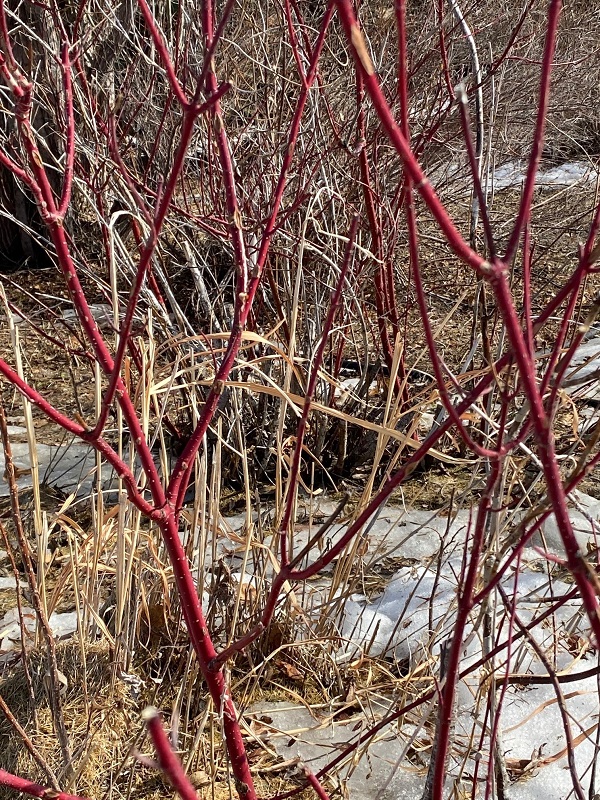
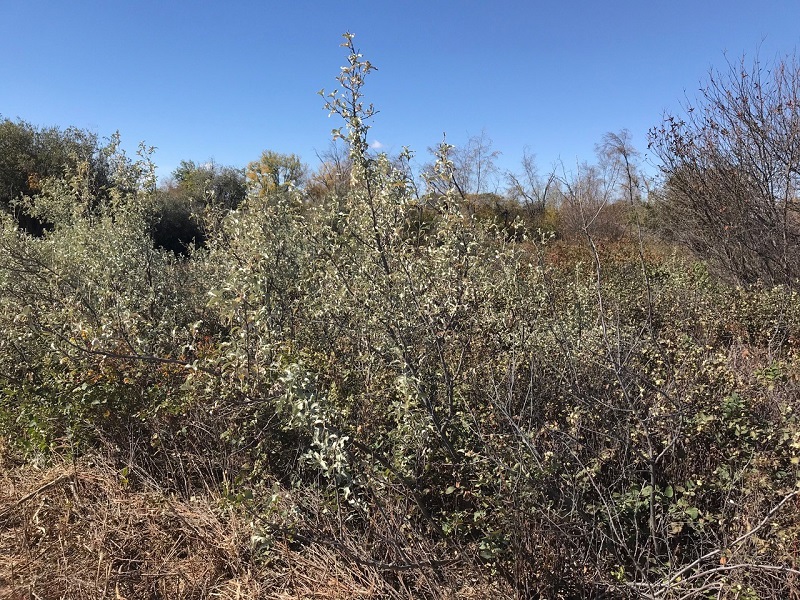
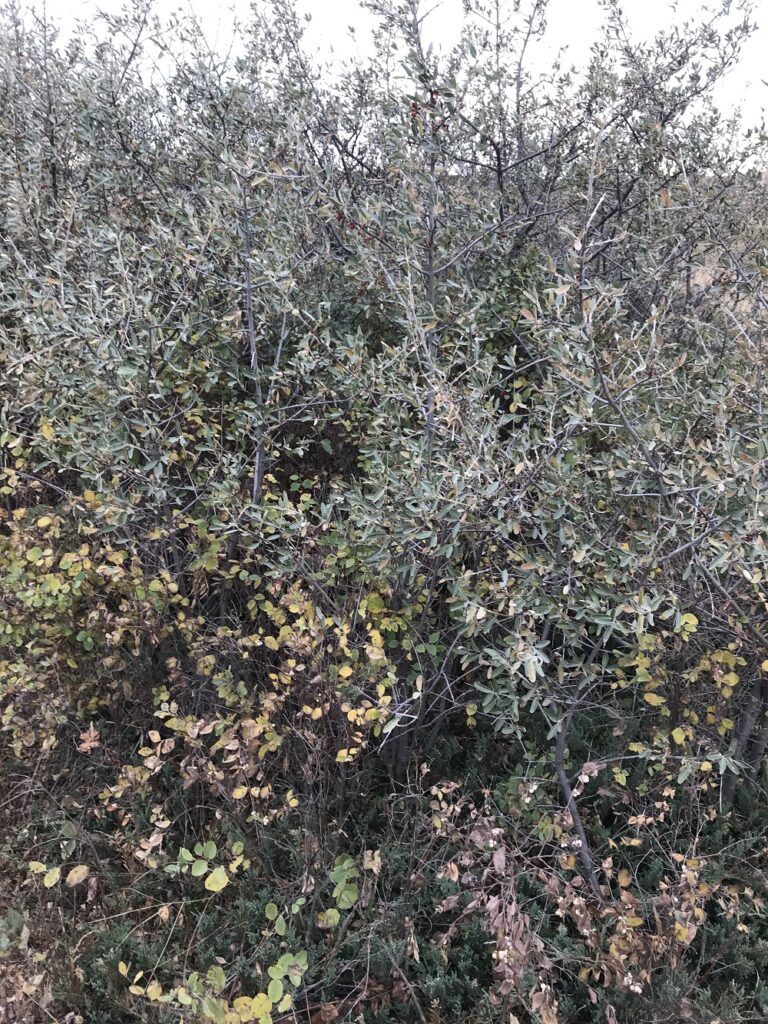
The regrowth of shrubs and forbs differs from grasses and legumes because shrub and forb buds are elevated from the ground, located on the tips of branches. During grazing, these buds get removed. If all the buds are removed, the shrubs and forbs will not regrow; therefore, some of the growing points must be left after grazing to survive the winter and initiate new growth the following spring. Forested rangelands are best grazed only once per season to maintain plant health and vigour and allow grazed plants to regrow and replenish energy reserves prior to winter.
It is recommended to graze only 25% of the total forage production on forested rangeland. This will ensure growing points are intact to sustain shrub and forb growth, leaves adequate plant litter to build soil organic matter, facilitates nutrient and water cycling, protects soil from wind and water erosion by moderating temperatures, and allows complementary land use for wildlife habitat, recreation, and timber regeneration.
Timing of forest grazing is important. If plants are grazed too early, their energy reserves are reduced, negatively affecting their overall health and ability to produce new growth. This will affect the long-term sustainability of the plant community. Spring growth is slow in forested rangelands due to the shading effect of the trees, slow snow melt and cool soils. Tame pasture and native grasslands will be ready for grazing prior to forested rangelands. Forage production and nutritive value of shrubs and forbs in forested rangelands is usually best in mid-June to August.
When introducing livestock into forests for grazing, it is useful to understand the age of the forest and the stage that the forest is in. The age of the forested area will influence the vegetation, the wildlife and bird communities. Succession, which is the process of forest aging, impacts landscape and biological diversity, as well as plant and animal populations. The soil, microclimate, vegetation, animal and microbial components will experience changes due to the age of the forest. Forest stands evolve in a complex and diverse manner. In unmanaged forests, natural disturbances such as fire, windthrow (the uprooting and overthrowing of trees by wind), landslides and insects create a full range of age stages. Some species are best suited to open, freshly disturbed sites and young forests (0-50 years), while the ecosystems in a mature (50-200 years) or ancient forest (500-600 years) will support the plant and animal species that have adapted to thrive in those conditions. Balancing natural disturbances with timber harvest and livestock grazing can sustain microbial, vegetative, and animal communities at various forest growth stages.
Livestock behaviour and type of cattle must be considered when planning forest grazing. For example, a herd of yearlings can travel greater distances to water and utilize rugged terrain or less preferred areas better than a cow/calf herd. Naive cattle may not seek out forage as efficiently as experienced cattle that have previously grazed the forested area. Herds that have previously grazed a forested rangeland will develop home ranges within the preferred grazing areas and different herds may utilize the same rangeland in unique ways. Animals that are adapted to the range conditions will make the most efficient use of the forage available. Monitor livestock and ranges closely to determine forage utilization and modify grazing plans where necessary.
Methods of Forest Grazing
Methods of grazing forests include turning livestock out into the forest, forest grazing and silvopasture:
Turning livestock out into the forest – this management system is based on the need to access additional forage, shrubs, or forbs in order to rest other pastures. It may also be used to control invasive plants by turning livestock into the forested areas for short durations. This grazing system involves turning livestock out into forested areas to continuously graze. Minimal infrastructure is used, and cattle are often herded rather than controlled with fencing. This grazing system can result in livestock overgrazing the preferred range and lead to degradation of both the trees and the forage if cattle are allowed to graze the same area for too long. Land may also be at risk of compaction and erosion in areas where cattle congregate or overgraze. While private landholders in some provinces may still be able to utilize this grazing strategy, the risk of overgrazing often prohibits its use on Crown land. Proper timing of grazing and rest periods are vital to prevent cattle from overgrazing.
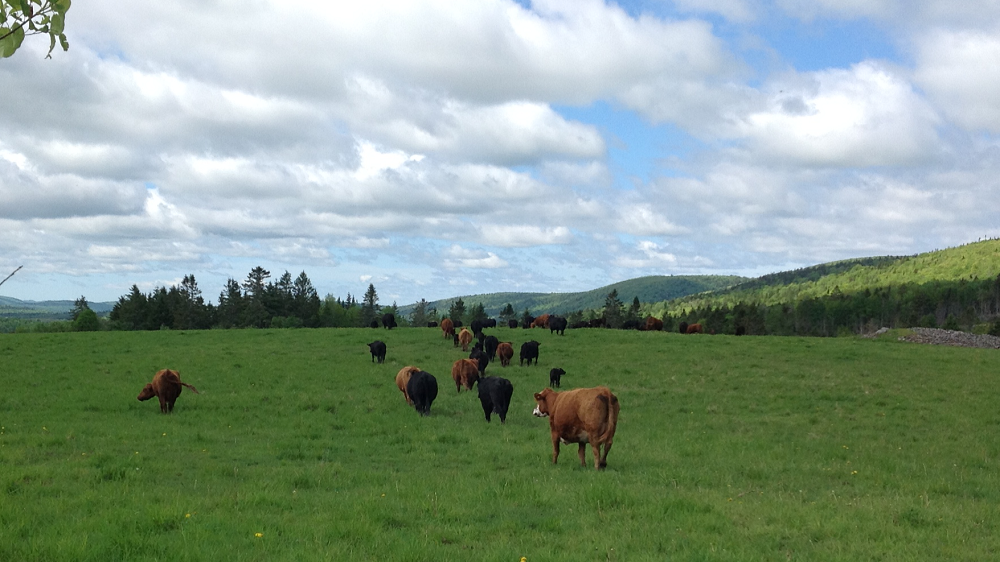
Forest grazing – the primary objective of this system is providing pasture for livestock. Forest grazing tends to require additional infrastructure such as fencing and water systems. This method allows producers to utilize natural forested areas to increase available grazing days and is the most common among beef cattle operations using forested areas across Canada. Water sources, fencing and attractants such as salt and mineral are utilized in a rotational grazing system to use the grass, forbs and shrubs at the correct times to meet livestock nutritional requirements. Fencing may be used to reduce direct access to rivers or streams to preserve riparian areas. Corridors for wildlife may be created to facilitate their movement. As with any type of grazing, a grazing management plan should be created and monitored, ensuring appropriate rest periods. This plan should also include weed and brush control strategies. The native plant community is best strategically grazed when the trees are younger and the canopy is more open, which allows more light to reach the forest floor. As the forest matures, the canopy closes, reducing the understory plants, shrubs and browse. Once the canopy cover exceeds 50%, grazing often becomes unfeasible. Privately owned forested areas allow for greater management flexibility. Crown owned lands will require Grazing Timber Agreements, communication and collaboration to design, monitor and operate the integrated operations.
Silvopasture – this management system integrates forest, forage and livestock to derive value from both timber and livestock.
Silvopasture – this management system integrates forest, forage and livestock to derive value from both timber and livestock. It generally requires greater management and higher capital costs for fencing, water systems and planting of trees, and can involve either introducing cattle into forested areas or introducing trees into existing pastures. In forests with fast growing, mid value timber, silvopasture can be incorporated as a way to maximize utilization of both timber and forage for livestock, while providing income diversity. Continuous grazing is not suitable with this system; rotational grazing should be used to reduce potential damage to trees, understory or forage species, and to allow paddocks time to rest and recover. Managed properly, this agroforestry practice provides feed and shelter for livestock, maintains biodiversity of vegetation, animal and microbial communities, and enhances the health of the forest, while providing another income stream.
Silvopasture practices support a wide range of trees, herbaceous plants, grasses and forbs that provide a diverse mixture of feed sources for livestock and wildlife. While these complex systems offer many benefits, they require more management. Regional conditions, such as microclimates within the forested area, generally require customizing management strategies to match available resources and conditions. There is no one-size-fits-all approach. A silvopasture system is dynamic, so management practices will change according to the growth stage of the trees. Young forest stands can be trampled by cattle, so stock density and grazing period must be restricted to allow tree growth. Even once established, young trees may be at risk of rubbing or damage by cattle. Conversely, livestock can be useful for vegetation management to reduce undesirable brush. Regular monitoring will be required to adjust stocking rates if necessary and minimize the impact of grazing upon both the forage and the trees.
In areas with very high value trees, silvopasture may be less suitable, as the focus in those forested areas is on the successful planting, growth and harvest of timber, rather than the production and utilization of forage for livestock. However, innovative research conducted by a diverse group of collaborators in British Columbia explored the integration of cattle, forage and trees to evaluate the potential for increased forage and timber productivity in mid-rotation conifer stands. Co-benefits of carbon sequestration, plant diversity and soil water availability were also evaluated.
The following photos illustrate the use of strip thinning investigated in this research project, allowing forage to grow in the unforested strips. This also allows more sunshine to reach the trees that remain standing, improving their growth.
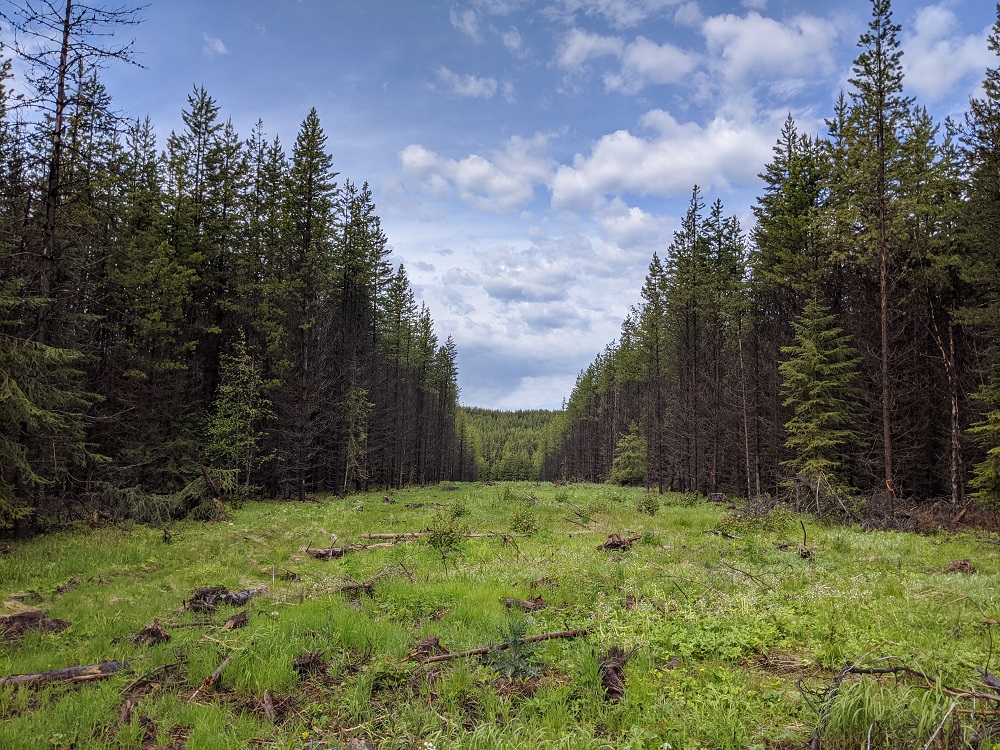
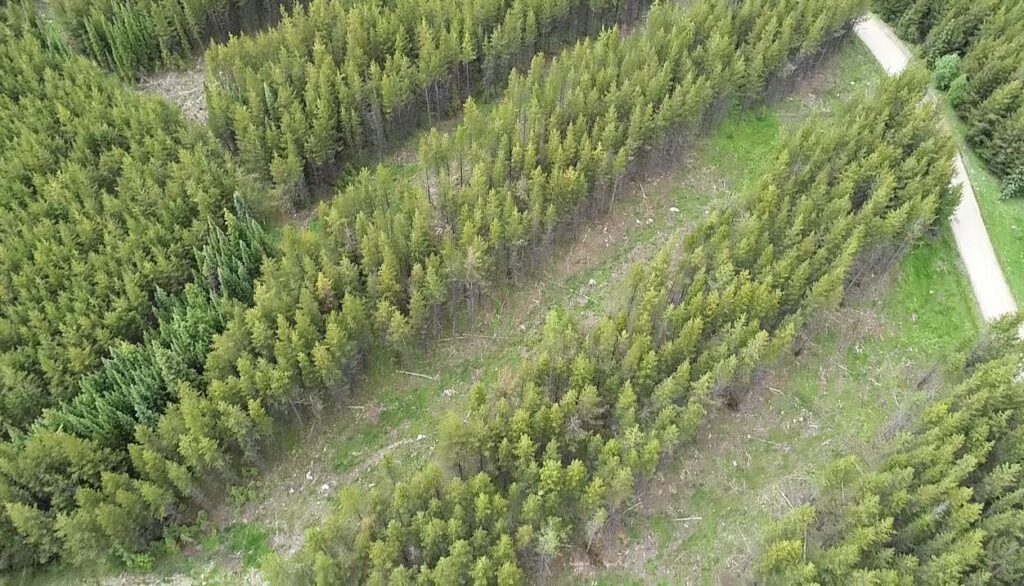
Thinning added to forage biomass and diversity. The following YouTube video presented by the BC Cattlemen’s Association further highlights some of the results from this research.
Video: Integrating Cows, Forage and Trees
Agroforestry systems will incorporate livestock with regionally appropriate best management practices that may vary from season to season. Wintering cattle within an agroforestry system may look quite different from system to system and region to region. For example, on smaller, privately owned woodlots, such as in the Maritimes, the trees can provide a valuable source of shelter for livestock, with water development or mineral supplementation to ensure nutritional needs are met. This can allow producers to monitor cattle in a smaller area during calving and facilitate supplemental feeding if required during winter. It can also help reduce predation of young calves. In British Columbia, cattle are often grazed from spring to autumn in an expansive system where they have access to large areas of forested grazing. During winter, livestock return to lower elevations at the home yard site or pasture area. Implementing best management practices to manage manure and nutrients in these winter-feeding areas with higher livestock density is part of successful management.
Weed Control in Forested Grazing
As livestock utilize forested areas for grazing, weed communities will be impacted. Producers who own and control the land base may want to consider developing a weed management strategy to identify, track and control undesirable, toxic or noxious weeds. On Crown lands where both timber and livestock operators are utilizing the forested area, weed species and their control are the responsibility of both parties. Weed control methods, including cultural, mechanical and chemical may be combined for best results.
In these shared areas, brush control will also be a consideration since the successful reforestation of harvested cutblocks is a priority. Deciduous suckers achieve the highest level of palatability in June of the year following harvest3. Livestock with access to these cutblocks may selectively overgraze the seedlings. In coniferous cutblocks, controlled grazing can be useful for removing competing vegetation and reducing the need for herbicide treatments.
Weeds on overlapping grazing and timber dispositions will impact both operations, with certain species of vegetation viewed differently by each stakeholder. Communication while developing weed control strategies is key to ensure desired outcomes are achieved, while mitigating negative impacts to the other user.
Tips and Strategies for Implementing Forest Grazing
Forest grazing can provide resources including shelter, forage, and browse for livestock. Protecting and preserving Canadian forests requires producers to comply with local, provincial and federal regulations. Producers with private land holdings have more flexibility in creating grazing strategies that incorporate forested areas.
Video: How to Calculate Carrying Capacity
While basic principles of grazing management such as using appropriate stocking rates, controlling weeds, avoiding damage to sensitive areas and monitoring animal condition apply, some additional considerations are suggested when implementing forest grazing:
- start on a small scale to monitor and assess results
- conduct a site assessment to determine resources available, including soil type, dominant tree species and forage available for grazing
- contact local government offices for regional information and woodlot groups and associations to learn best management practices for local conditions
- determine a plan to best utilize the forested area, such as integrating cattle into the forest or silvopasture
- have a back-up plan to provide adequate forage for livestock
- if seeding forages in forested areas, remember that warm season grasses (C4) perform poorly in shade, while cool season grasses (C3) have better shade tolerance and generally perform better
- do not graze more than 25% of forage in forested areas and graze only once per season
- delay grazing until grasses are actively growing, which may be as late as June in some areas due to shading and cooler temperatures in the forested areas
- match cattle type to the environment (i.e., use yearlings in areas that require animals to travel over longer distances)
- identify preferred and less preferred ranges to better manage livestock distribution
- consider using electric fencing, and salt, mineral and water placement to control cattle movement and improve forage utilization
- in some areas, predation can be problematic; bears, cougars and wolves can cause significant losses and young calves may be at greater risk in these areas
- learn ways to monitor and assess forest health
The following publication illustrates some examples of objectives and best management practices when implementing forest grazing. These may vary regionally; contact local ministries of forestry to access province specific information.
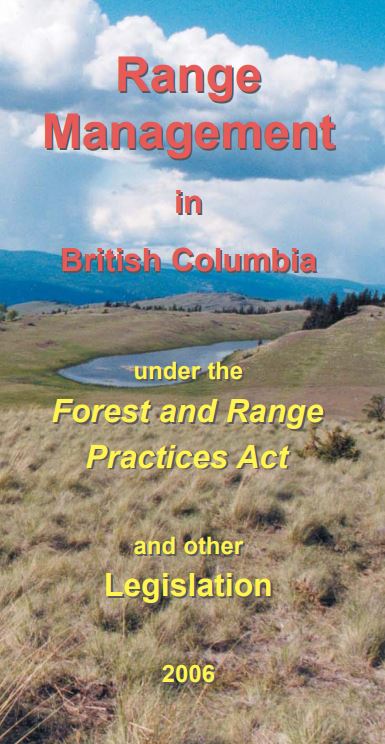
The Woodlot Management Guide for Alberta, provides information on beneficial management practices for woodlots and for incorporating livestock into woodlots.
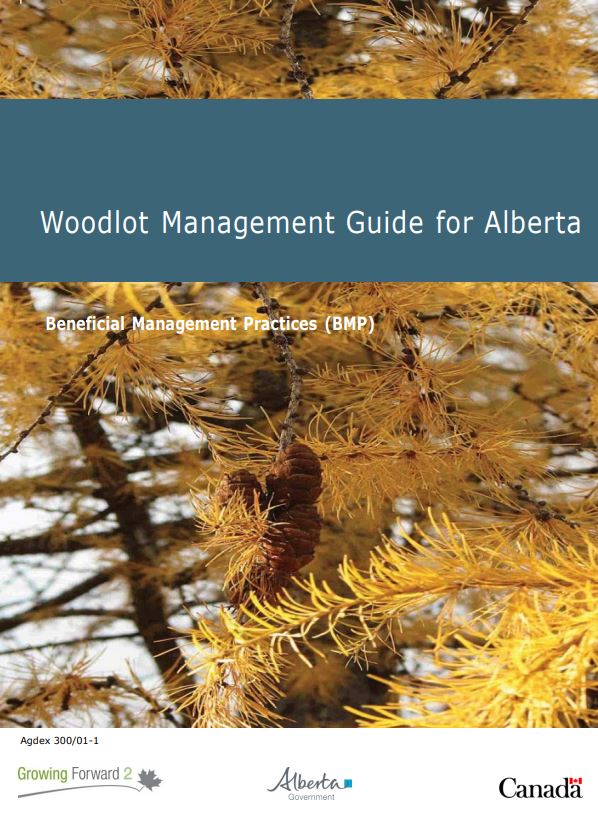
Conclusion
Forested rangelands are widespread in Canada and forestry is an important contributor to the Canadian economy, to rural communities, to the climate, to wildlife, and to the environment. Integrating livestock through agroforestry or silvopasture encourages efficiencies between these industries. These forested areas can provide cattle with forage, water, and shelter from heat and cold. Management systems that successfully incorporate livestock into forest rangelands by carefully balancing the benefits and risks of livestock grazing on forested lands can improve economic and environmental outcomes. Challenges that relate to lack of research and knowledge, absence of incentives and niche markets, labour costs and regulatory hurdles vary regionally. Opportunities exist to further develop these synergies through ongoing and future research, collaboration among stakeholders, and a continued focus on the many ecosystem services provided by forested areas.
- References
-
1 Natural Resources Canada, Canadian Forest Service. 2023. The State of Canada’s Forests. Annual Report 2023. Ottawa, ON.
2 Aalde, H., P. Gonzalez, M. Gytarsky, T. Krug, and W. Kurz. 2006. Forest land. In: 2006 IPCC Guidelines for National Greenhouse Gas Inventories, Volume 4 (Agriculture, Forestry and Other Land Use)
3 Dockrill, C. W. M. 2001. Effects of cattle and wild ungulate foraging on trembling aspen regeneration in Alberta’s Lower Boreal Forest. M.Sc. thesis. Department of Agricultural, Food and Nutritional Sciences, University of Alberta.
Feedback
Feedback and questions on the content of this page are welcome. Please e-mail us at [email protected]
This content was last reviewed December 2024.
